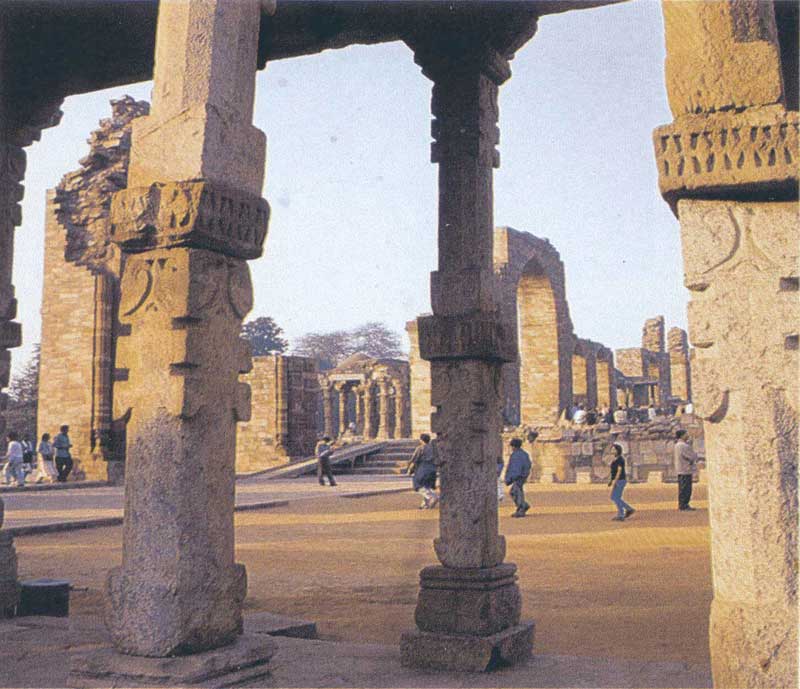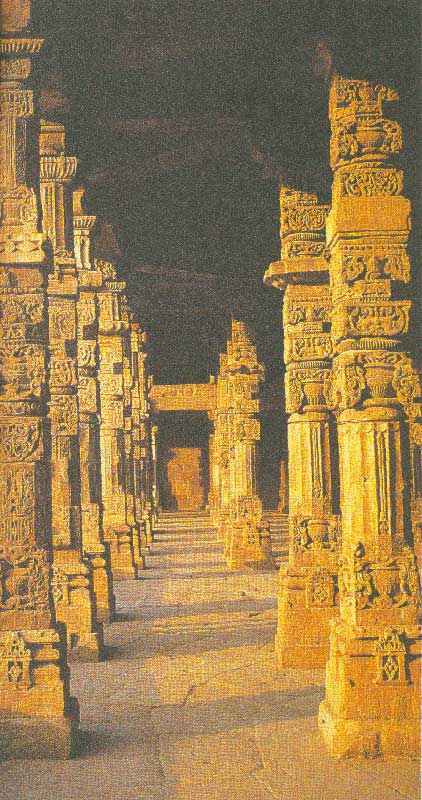 |
 |
|
Screen Arches of Quwwat-ul-Islam mosque |
Quwwat-ul-Islam mosque, view from Qutb Minar |
|
|
Qutb Complex, - Quwwat-ul-Islam Mosque
 |
 |
|
Screen Arches of Quwwat-ul-Islam mosque |
Quwwat-ul-Islam mosque, view from Qutb Minar |

 Barring the pre-Sultanate monuments of Kutch District, this is the earliest extant mosque in India and consists of a rectangular court, 43.2m by 33m, enclosed by cloisters, erected with the carved columns and other architectural members of twenty-seven Hindu and Jain temples demolished by Qutbu'd-Din Aibak, as recorded by him in his own inscription on the main eastern entrance. Qutbu'd-Din calls the mosque as Jami Masjid and states that on the original erection of each of the demolished temples a sum of twenty lacs of coins had been spent. Later it came to be called the Quwwatu'I-lslam (might of Islam) mosque. The western portion of its courtyard occupies the original site of one of the demolished temples. At the two ends of its eastern cloisters, an intermediate storey was raised to provide compartments for the ladies. An iron pillar from Vishnu temple of the fourth century which had been earlier set up here probably by Anangpal, stands in front of the prayer-hall.
Barring the pre-Sultanate monuments of Kutch District, this is the earliest extant mosque in India and consists of a rectangular court, 43.2m by 33m, enclosed by cloisters, erected with the carved columns and other architectural members of twenty-seven Hindu and Jain temples demolished by Qutbu'd-Din Aibak, as recorded by him in his own inscription on the main eastern entrance. Qutbu'd-Din calls the mosque as Jami Masjid and states that on the original erection of each of the demolished temples a sum of twenty lacs of coins had been spent. Later it came to be called the Quwwatu'I-lslam (might of Islam) mosque. The western portion of its courtyard occupies the original site of one of the demolished temples. At the two ends of its eastern cloisters, an intermediate storey was raised to provide compartments for the ladies. An iron pillar from Vishnu temple of the fourth century which had been earlier set up here probably by Anangpal, stands in front of the prayer-hall.
The mosque was begun in 1192, immediately after the capture of Delhi by Qutbu'd-Din, and completed in 1198. Later, a massive stone screen was erected in front of the prayer-hall, consisting of a central arch, 6.7 m wide and 16m high, with two similar but smaller arches on either side, all ogee-shaped. Except for the apex, where the few stones are laid in the manner of voussoirs, the construction of the arches is corbelled. The screen is beautifully carved with borders of inscriptions and geometrical and arabesque designs, but the hand of craftsmen used to Hindu motifs is clearly perceptible in the naturalistic representation of serpentine tendrils and. undulating leaves of its scroll-work and even in the fine characters of the Quranic inscriptions.
The mosque was enlarged by two later rulers. Shamsu'd-Din Iltutmish (1211-36), son-in-law and successor of Qutbu'd-Din, doubled the size of the mosque in 1230 by extending its colonnades and prayer-hall outside the original enclosure, with the result that the Qutb-Minar now fell within the mosque-enclosure. The arches of Iltutmish's screen are still principally corbelled, although their arabesque ornamentation with the inscriptions standing out prominently is Saracenic in feeling, as distinct from the mixed decoration of Qutbu'd-Din Aibak's screen. 'Alau'd-Din Khilji (12961316) again extended the mosque substantially by enlarging the enclosure. He provided two gateways on the longer eastern side and one each on the north and south, the last one known as 'Ala-i-Darwaza and still extant in entirety. In fact, he doubled the area of the mosque, and also commenced the construction of another minar, intended to be twice the size of Qutbu'd-Din's minar, although it remained incomplete
 |
 |
| Richly ornamented columns of Quwwat-ul-Islam mosque |
Cloisters of the Quwwatul-ul-Islam mosque |
|
|